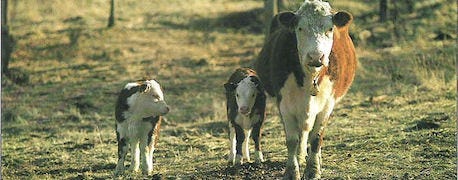
Twinning in beef cattle could help address the often low return on investment of cow-calf operations but it seems no one, besides researchers, thinks it a good idea.
No amount of searching by the author has found any beef operations which have adopted twinning as standard practice.
The best-known research on twinning was conducted by the US Meat Animal Research Center at Clay Center, Neb., from 1981 to 2012. By 2001 the researchers had moved the twinning percentage from 4% or less in various breeds up to 50%. This was all done by selection for cattle that twinned. The rate still stood at 50% when US-MARC says the project was abandoned in 2012.

A 30-year study of twinning suggests more work but more profit. Apparently beef producers aren't buying. (Photo: University of California)
US-MARC held a semen sale from the twinning herd April 14-16, 2014. From the US-MARC data sprang some interesting information which is at least worth reading.
On the positive side, twinning offers significant increases in calf weight per cow exposed.
Although twinning reduced calf survival, dams producing twins at birth weaned 70.8% more calves than dams with a single birth. This resulted in a 48.1% increase in total weaning weight (740 pounds vs. 499.6 pounds), according to US-MARC researchers in a 2002 paper.
A brief spreadsheet from Michael L. Thonney, a Cornell animal science professor, suggests a 50% twinning rate could increase herd returns by more than 50% in a wetter environments which have ample forage and nutrition.
However, all the research papers stress that a twinning herd requires much higher calving management and better nutrition. Cows nursing twin calves require about 13% more energy intake to maintain body condition, for example.
~~~PAGE_BREAK_HERE~~~
In that vein, researcher K.A. Nephawe wrote in his paper for the 2002 Beef Improvement Federation conference that the biggest changes in management required by such a herd would be determination of pregnancy status with regard to single vs. twin pregnancies ahead of calving. This would allow the manager to feed a higher plane of nutrition to twin-pregnancy cows and to know which would need to be kept close by for obstetric care.
Nephawe also suggested, "A high level of intensive management ... is required for a twinning technology in cattle to increase economic productivity.
Improvements in genetics and/or management for dystocia, calf survival and rebreeding rate will be required to make a production system based on twinning economically feasible."
Then he added these thoughts: "Although the likelihood of achieving a workable system of twinning could be low because intensive management systems for beef cattlewould seem to be unpractical in much of the U.S., there are regions where farmers have abundant feed resources and would be able to devote enough of their time to calving out cows prior to spring planting."
Keith Gregory, one of the main researchers who studied twinning in beef cattle at US-MARC, listed these facts about twin birthing cows when compared with single-birth counterparts:
• Shorter gestation lengths
• More retained placentas
• More dystocia
• More days to estrus
• Lower conception rates
• More days to pregnancy
Gregory said days to estrus, conception rate and days to pregnancy were not affected by number of calves reared in cows birthing twins.
~~~PAGE_BREAK_HERE~~~
He added that survival at birth was greater for single-born than for twin-born calves, but twins and singles did not differ in postnatal survival.
When cows had dystocia, calf survival at birth was 95% for singles and 73% for twins compared with 99% vs. 92% when no dystocia was experienced, he added.
Further, calves born as twins were lighter at birth, 100 days and 200 days, but twins and singles did not differ in post-weaning gains. Total calf weights at 100 days per cow calving were 12% greater in cows birthing twins vs. singles, when twin calves reared by foster dams were excluded. Put another way, this suggests the smaller calves just needed longer to reach equivalent weights with their single-born counterparts.
One more negative factor is not mentioned in the studies: Cattle selected specifically to twin have not been selected for other traits, including adaptability and survivability. Some beef producers may see these factors as further red marks against such a plan.
About the Author(s)
You May Also Like




